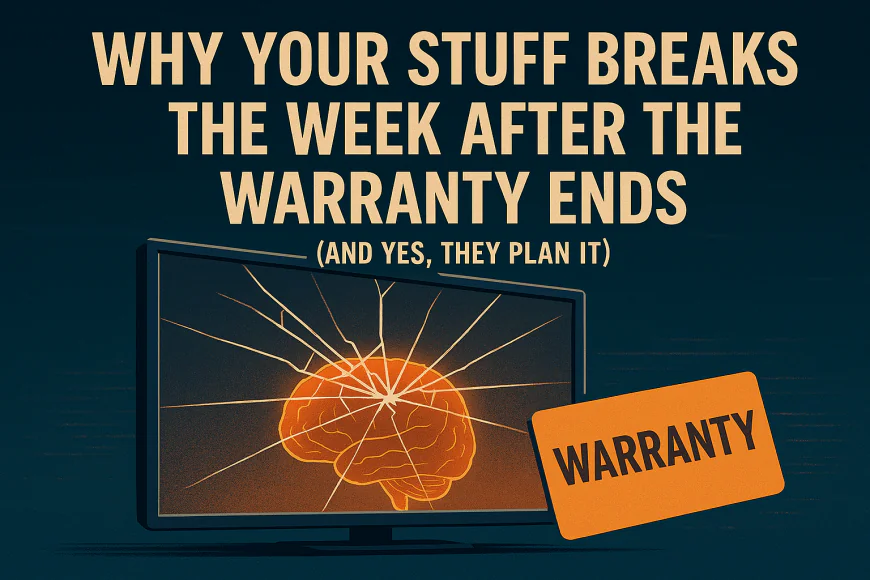Why Your Stuff Breaks the Week After the Warranty Ends (And Yes, They Plan It)
Your TV’s not haunted—it’s manufactured betrayal. You finally bought the blender. Or the gaming console. Or that slick new fridge with the digital readout. You kept the receipt. You got the warranty. And like clockwork—right after it expires—your device sputters, flickers, gasps... and dies. That’s not bad luck. It’s designed failure. And once you see the blueprint, you won’t unsee it.

🧠 The “Planned Obsolescence” Trap—Upgraded
Let’s rewind. Planned obsolescence is the original hustle: make products with just enough lifespan to survive the first sale, then force replacement or upgrades. But today’s manufacturers have refined it. It’s not just wear-and-tear—it’s strategic engineering to fail near the edge of coverage.
They call it “warranty calibration.” We call it intentional sabotage.
🔧 Engineered Fragility: How They Build the Breakdown
Behind closed doors, product teams utilize life-cycle prediction software to model the lifespan of a part, taking into account materials, stress, temperature, and usage.
-
Plastic gears instead of metal in high-friction parts
-
Cheap solders that crack from heat but pass quality tests
-
Battery circuits designed with voltage limits that just tip over after 18 months
-
Capacitors in TVs and computers rated to degrade around the 12–15 month mark
These aren’t accidents. They’re budget decisions masked as innovation.
And yes—they know when your warranty runs out. That 12-month window? It’s not coincidence. It’s a benchmark baked into manufacturing specs.
💰 Why This Pays Off Big
Manufacturers figured out something dark: failures lead to profits.
-
If it breaks after warranty, you either pay for repairs ($$$) or buy a new one ($$$$)
-
Service departments profit from “just out of warranty” fees
-
Extended warranties are pushed as upsells—even though the product is rigged to make them relevant
Meanwhile, brand loyalty becomes a feedback loop:
“Oh, I’ll just get the updated version.” → New sale achieved.
Even better? Most people blame themselves: “I must’ve dropped it” or “Maybe I used it wrong.”
🧾 The Receipts: Industry Whistleblowers Speak
Tech and appliance insiders have spilled the truth:
-
One former electronics engineer said parts were rated precisely 18 months, based on warranty length
-
A designer at a major phone company confirmed that screens are tension-tested to crack outside the insurance window
-
Appliance repair pros have posted online parts lists that show “non-repairable designs”—items built to resist fix attempts
🚫 Built to Be Unfixable
Remember when you could open the back and swap a battery? Now you need:
-
A proprietary screwdriver
-
A heat gun
-
A prayer
Modern devices are often glued shut, or programmed with firmware locks that prevent repairs. Even if you could fix it, the software might block you.
Welcome to the warranty death spiral—where fixing your own stuff becomes legally or physically impossible.
📉 The Cost to Consumers
-
Americans spend over $1,400 a year replacing out-of-warranty items
-
Electronics contribute to e-waste spikes—millions of tons dumped annually
-
Low-income families are hit hardest: cheap products break faster, and repair options are priced out
And get this—recycling programs are often run by the same manufacturers who created the waste. A full-circle hustle.
🔥 Rebellion Is Brewing: Enter “Right to Repair”
Consumer outrage has birthed a movement:
-
Right to Repair laws are sweeping states—forcing brands to share repair manuals, parts, and tools
-
Activists are exposing the “warranty failure curve” in viral posts
-
Independent fix shops are building underground networks to bypass corporate lockdowns
If you thought tech companies were nervous before—wait until their service profits take a hit.
🛡️ What You Can Do
You can’t stop the cycle overnight, but you can slow it down:
-
✅ Buy brands with repair-friendly designs (modular, open-source, part-accessible)
-
🔍 Track product reliability scores (like Fixit Index or Consumer Reports)
-
📸 Post failure timelines—if your item dies right after warranty, tag the company
-
🧠 Push for transparency—ask for service schematics BEFORE buying
-
🧰 Learn repair basics—there are communities teaching DIY fixes that bypass the lockouts
Because no product should be born with a death date.
💥 The System’s Been Built to Fail. So Don’t Fail Quietly.
Next time your gadget dies like clockwork, don’t assume it’s random. It was probably designed that way. The good news? That awareness flips the script.
The real warranty should be between you and reality—not you and a corporation’s spreadsheet.
The moment enough people stop blaming themselves—and start calling out the strategy—is the moment planned breakdowns start to break them.
🔍 Need a Fact Check?
What's Your Reaction?
 Like
0
Like
0
 Dislike
0
Dislike
0
 Love
0
Love
0
 Funny
0
Funny
0
 Angry
0
Angry
0
 Sad
0
Sad
0
 Wow
0
Wow
0



























